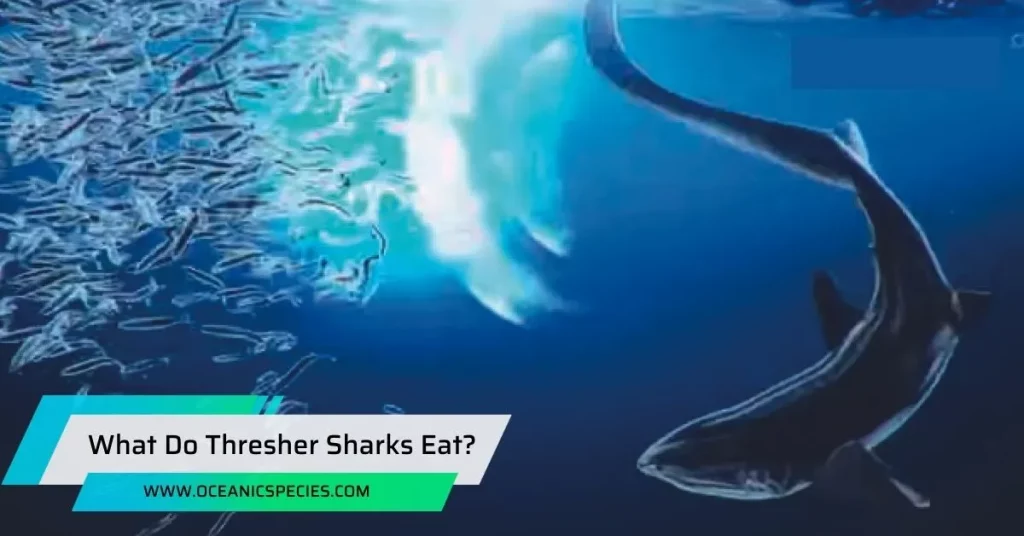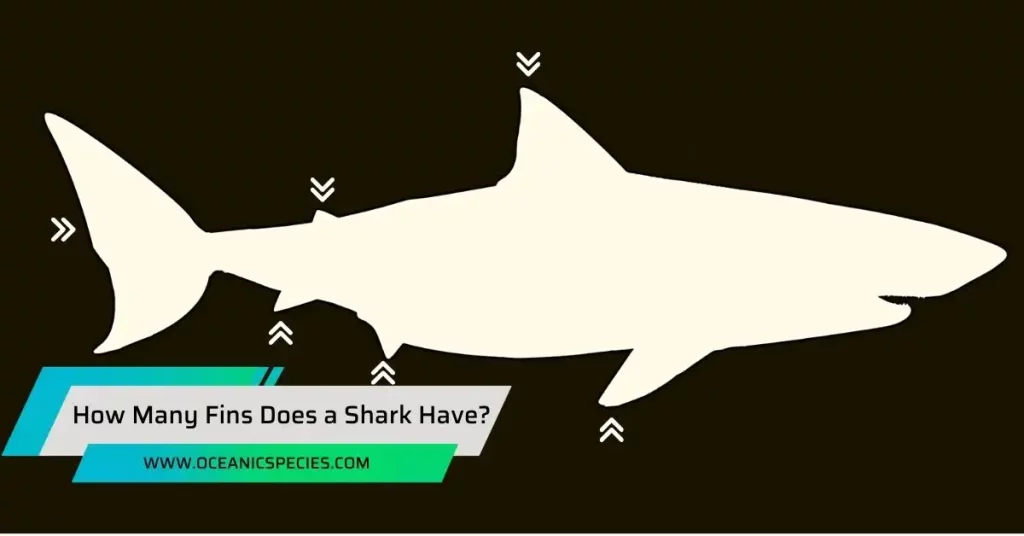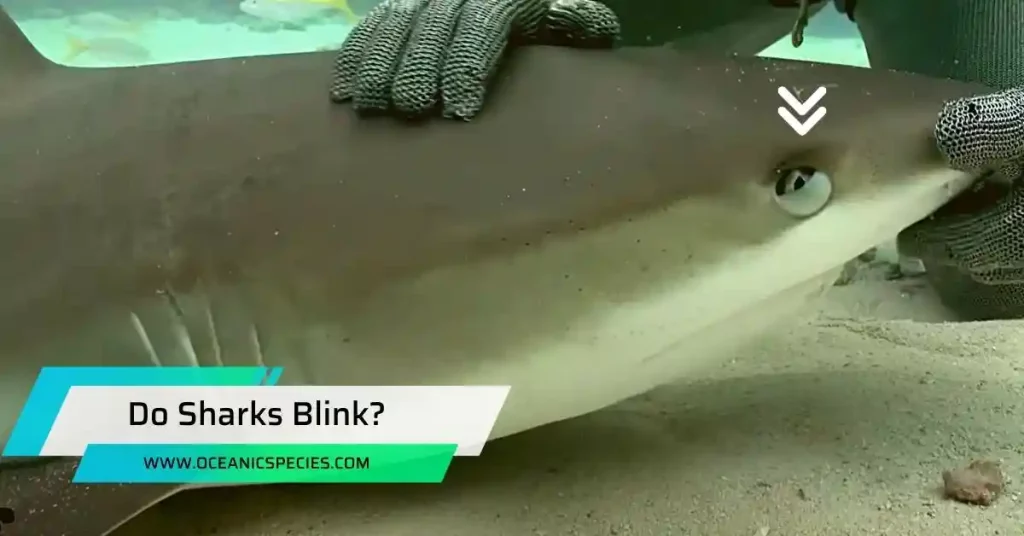Thresher sharks primarily eat small fish, squid, and sometimes even other sharks. Thresher sharks are known to be mainly piscivorous but their diet can also include a variety of other marine animals such as crustaceans and cephalopods.
These sharks have unique hunting techniques, using their long tails to stun and herd their prey. They are particularly skilled at capturing schooling fish, using their tails to thrash through the water and create shockwaves to disorient and immobilize their prey.
Thresher sharks are also known to leap out of the water while hunting, a behavior known as breaching. This allows them to target prey near the surface, increasing their chances of a successful hunt. The diet of thresher sharks can vary depending on the species and their geographic location, but they are generally opportunistic predators that feed on a wide range of marine life.
Unique Anatomy And Hunting Techniques
Thresher sharks are renowned for their unique anatomy and hunting techniques, which give them a significant predatory advantage in the underwater realm.
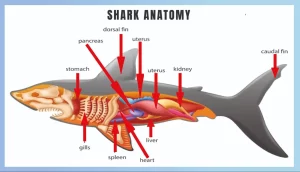
Let’s explore how these fascinating creatures leverage their specialized traits and strategies to become efficient hunters in their marine ecosystems.
Strategic Hunting Tactics Of Thresher Sharks
Thresher sharks employ a range of strategic hunting tactics to secure their prey. Here are some key methods they use:
- Tail slap: Threshers possess an elongated upper lobe in their caudal fin, resembling a scythe. They use this powerful appendage to deliver forceful tail slaps, stunning schools of fish and making them easier to catch.
- Cooperative hunting: These sharks have been observed hunting in groups, displaying impressive coordination skills. By working together, they can corral and herd their prey into a concentrated mass, increasing their chances of a successful hunt.
- Startling prey: Utilizing their rapid acceleration and agility, thresher sharks can swiftly approach their unsuspecting prey. They surprise their targets, disrupting schools of fish or squid, causing disarray and making it easier to single out individuals for consumption.
- Hunting in low light conditions: Some species of thresher sharks possess a unique adaptation known as a large and rounded eye, enabling them to hunt effectively in low light conditions. This advantage allows them to thrive in deeper waters, where their prey may be less likely to detect their presence.
Specialized Anatomy For Efficient Prey Capture
Thresher sharks have evolved specialized anatomical features that aid in efficient prey capture. Here are some remarkable adaptations that contribute to their hunting prowess:
- Elongated upper lobe: The thresher shark’s distinctive caudal fin, with its elongated upper lobe, grants them exceptional agility and speed underwater. This crucial adaptation allows them to execute swift and precise movements while pursuing their prey.
- Teeth adapted for efficient feeding: Thresher sharks possess strong and curved teeth, specifically adapted to capture and hold onto slippery prey. These teeth enable them to grasp and secure their prey effectively, preventing it from escaping their grasp.
- Long pectoral fins: Threshers have elongated pectoral fins, which aid in maintaining stability and maneuverability during high-speed pursuits. These fins help the sharks make swift turns and sudden changes in direction, ensuring they stay on the tails of their prey.
- Ampullae of lorenzini: Like other elasmobranchs, thresher sharks possess a network of specialized electroreceptor organs called ampullae of lorenzini. These organs allow them to detect the weak electrical signals emitted by their prey, enabling them to locate and capture them even in murkier waters.
Thresher Sharks’ Diet: Exploring The Menu
Thresher sharks have a diverse diet that includes small fish, squid, and even sea birds, thanks to their long tails, which they use to stun their prey. These apex predators efficiently navigate the ocean depths in search of their next meal.
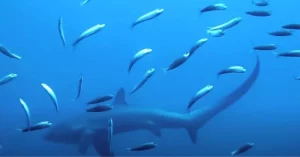
Thresher sharks are renowned for their distinctively long tails, which they use to stun or incapacitate their prey. With variations in species and habitats, thresher sharks have diverse dietary preferences. Let’s dive into the menu of these fascinating creatures and uncover what thresher sharks like to feast on.
Primary Prey Of Thresher Sharks:
Pelagic thresher sharks: These agile swimmers primarily target schooling fish such as mackerel and herring. They rely on their exceptional speed and sweeping tail movements to herd and stun their prey, making them an apex predator in the oceanic realm.
Examining The Diet Of Pelagic Thresher Sharks:
Bigeye thresher sharks: With their unique elongated upper lobe tails, bigeye thresher sharks possess an appetite for small to medium-sized fish like mackerel and pilchards. Their feeding strategies involve powerful whip-like tail strikes to immobilize their prey before devouring it.
Recounting The Feeding Habits Of Bigeye Thresher Sharks:
Common thresher sharks: Displaying a preference for schooling fish and squid, common thresher sharks utilize their incredibly long tails to whip and stun their prey. They are known to engage in spectacular leaping behaviors while hunting, providing an awe-inspiring sight.
Investigating The Dietary Preferences Of Common Thresher Sharks:
Thresher sharks, in addition to their primary prey, also exhibit opportunistic feeding behavior and have been observed consuming secondary prey that goes beyond their typical diet of fish and squid. Let’s explore further:
- They may consume small fish and squid: Thresher sharks are not limited to specific species but are opportunistic feeders. Thus, they are known to target various types of small fish and squid that cross their path.
- They exhibit an intriguing opportunistic side: Thresher sharks have been observed taking advantage of fishing gear left unattended, opportunistically devouring the ensnared catch.
Delving Into The Consumption Of Small Fish And Squid By Thresher Sharks:
Thresher sharks have been documented to display extraordinary hunting skills, even extending their diet to include birds and marine mammals. Although uncommon, this unusual prey demonstrates the adaptability and versatility of these remarkable predators.
The Unusual Prey Of Thresher Sharks: Birds And Marine Mammals:
Thresher sharks exhibit a wide range of dietary preferences, displaying the ability to consume an array of prey types, from small fish and squid to occasionally targeting birds and marine mammals. These feeding habits contribute to their ecological role as top predators in their marine ecosystems.
The Ecological Role Of Thresher Sharks
Thresher sharks play a crucial ecological role by maintaining balance in marine ecosystems. As apex predators, they have a diverse diet that includes small fish, squid, and sometimes even other sharks, contributing to the overall health and stability of the food chain.
Thresher sharks, with their distinctive long tails, are fascinating creatures that play a crucial ecological role in marine ecosystems. These oceanic keystone predators have a significant impact on fish populations, contributing to the delicate balance of the underwater world. Let’s explore how thresher sharks influence the food web and maintain the equilibrium of marine life.
Oceanic Keystone Predators: Thresher Sharks And Marine Ecosystems
Thresher sharks are considered oceanic keystone predators due to their position in the food chain. Through natural selection, these sharks have evolved to become skilled hunters, often relying on their long tails to stun and capture prey. With their strong jaws and excellent swimming abilities, they maintain stability in marine populations by regulating the number of species they feed on.
Balancing Prey And Predator: Thresher Sharks’ Impact On Fish Populations
Thresher sharks primarily feed on smaller fish, such as sardines, anchovies, and mackerel. By preying on these fish, thresher sharks prevent overpopulation, ensuring that fish populations do not exhaust the resources available to them. This helps maintain healthy fish populations and prevents disruptions in the delicate balance of marine ecosystems.
The Ripple Effect: How Thresher Sharks Influence The Food Web
The influence of thresher sharks extends beyond their direct impact on fish populations. As predators, they control the abundance of certain fish species, which in turn affects the populations of their prey. For example, if thresher shark populations decline, it can lead to an increase in the number of smaller fish and a decrease in the abundance of their prey, causing a cascade effect throughout the food web.
Frequently Asked Questions
What Do Thresher Sharks Eat In The Wild?
Thresher sharks mainly feed on small pelagic fish, such as mackerel, sardines, and anchovies.
Do Thresher Sharks Eat Other Sharks?
Thresher sharks are known to occasionally eat smaller species of sharks, but they primarily feed on fish.
How Often Do Thresher Sharks Eat?
Thresher sharks typically feed on a daily basis, but their feeding habits can differ based on food availability and hunting success.
Where Do Thresher Sharks Find Their Food?
Thresher sharks can be found in both coastal and open ocean areas where their prey, such as schooling fish, is abundant.
Can Thresher Sharks Eat Humans?
Thresher sharks are not considered a threat to humans as they prefer to feed on small fish and rarely come into contact with humans.
Conclusion
Thresher sharks are fascinating creatures with unique feeding habits. Through our exploration of their diet, we have discovered that these apex predators mainly consume a variety of schooling fish, including sardines, mackerel, and herring. Their long, whip-like tail serves as a powerful tool to stun and immobilize their prey with a quick, forceful strike.
This enables them to easily catch their food despite their large size. While they primarily feed on fish, thresher sharks have also been known to consume squid and occasionally smaller sharks. This flexible diet allows them to thrive in a wide range of marine habitats.
As we continue to study these remarkable sharks, it becomes clear that their well-adapted feeding strategy contributes to their success as top predators in the ocean. Understanding the dietary habits and ecological role of thresher sharks is vital for marine conservation efforts, as it highlights the importance of protecting their prey species and habitats to ensure the survival of these majestic creatures.

